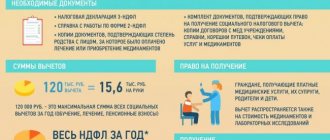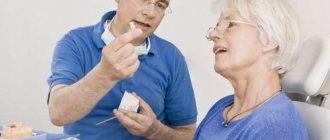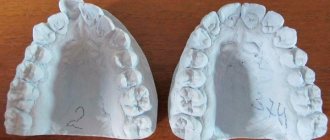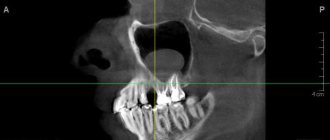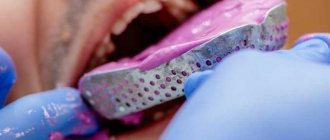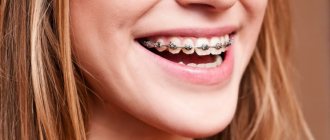What is a tax deduction for treatment?
According to the legislation of the Russian Federation (Article 219 of the Tax Code of the Russian Federation), when paying for treatment or medications, you can count on a tax deduction and return part of the money spent on treatment .
A tax deduction is the portion of income that is not subject to tax. Therefore, you can return the tax paid on the expenses incurred for treatment. If you officially work and pay income tax, have paid for your treatment or the treatment of your relatives , you can get back part of the money in the amount of up to 13% of the cost of treatment .
How to fill out the “Deductions” section in 3-NDFL for expenses on dental prosthetics (example)
The list of medical services (approved by Government Decree No. 458) is not subject to broad interpretation, therefore it will not be possible to receive an unlimited deduction for expenses, for example, on dental prosthetics - this is the wording of medical services that is not in the List.
Let's supplement the conditions of the previous example to understand how to calculate personal income tax when making expenses for dental prosthetics.
Example 2
Engineer Kulikov Z.N. in 2022 spent his own savings in the total amount of 363,000 rubles. for your treatment, including:
- 182,000 rub. for joint replacement (medical code);
- 14,000 rub. for diagnostic procedures (code “01”);
- 167,000 rub. for dental prosthetics (code “01”).
To calculate the amount of personal income tax to be returned from the budget, it is necessary to determine the amount of expenses for treatment that is not considered expensive:
SL = 14,000 rub. + 167,000 rub. = 181,000 rub.
Since SL > 120 thousand rubles → SL = 120,000 rubles.
Personal income tax return = (182,000 rub. + 120,000 rub.) × 13/100 = 39,260 rub.
Instead of the calculated amount of treatment costs (181,000 rubles), 120,000 rubles are included in the formula. – the limit established by clause 2 of Art. 219 of the Tax Code of the Russian Federation.
When filling out the 3-NDFL declaration for treatment, Z. N. Kulikov indicated in the “Deductions” section:
Calculating personal income tax and filling out a declaration is only part of the actions of the general scheme for obtaining a deduction for treatment. An important stage of this process is the collection of supporting documents - more on this later.
In what cases can you get a tax deduction for treatment?
You can take advantage of the social tax deduction for treatment and get part of your expenses back in the following cases:
- You can get a tax deduction when paying for medical services, If:
- paid for services for their own treatment or treatment of close relatives (spouse, parents, children under 18 years of age) provided by medical institutions in Russia;
- paid services are included in a special list of medical services for which a deduction is provided. The list of services is defined in Decree of the Government of the Russian Federation dated March 19, 2001 N 201.
- the treatment was carried out in a medical institution licensed to carry out medical activities;
- You can get a tax deduction when paying for medicines, If:
- paid at their own expense for medications for themselves or their immediate relatives (spouse, parents, children under 18 years of age) prescribed by the attending physician.
- You can get a tax deduction when paying for voluntary health insurance, If:
- paid insurance premiums under a voluntary health insurance agreement or insurance for immediate relatives (spouse, parents, children under 18 years of age);
- the insurance contract only provides for payment for treatment services;
- the insurance organization with which the voluntary insurance agreement has been concluded has a license to conduct the corresponding type of activity.
3-NDFL for treatment: sample filling
You do not need to fill out all sheets of the deduction declaration. Only the necessary pages are used. For paper declarations, only one-sided printing is allowed.
If the taxpayer reports only a deduction for treatment, it is sufficient to include in the composition:
• title page;
• section 1 and its appendix – application for tax refund;
• section 2;
• Annex 1;
• Appendix 5.
The TIN of the individual is written at the top of each page of the declaration, the date and signature are placed at the bottom, empty fields are crossed out.
The tax in the declaration is indicated in whole rubles, the remaining cost indicators (income, expenses) are in rubles and kopecks.
Encoding used
Some data in the declaration is indicated in the form of special codes, some of which are given in the appendices to the Procedure for filling out the declaration, for example:
- The Federal Tax Service Inspectorate and OKTMO numbers are determined by the taxpayer’s place of residence; they can be clarified in your inspectorate or on the Federal Tax Service website.
- The title page indicates period codes “34”, country (RF) “643”, taxpayer category for individuals (not individual entrepreneurs) – “760” (Appendix No. 1 to the Procedure), status “1” (residents - persons who were in territory of the Russian Federation more than 183 days a year).
- In section 1 on page 010, the code “2” is placed, indicating that the tax is subject to refund; below is the BCC of the tax - 18210102030011000110.
- In section 2 the tax rate is 13%, on page 002 “Type of income” the code “3” is indicated - other.
- The codes of types of income indicated in Appendix 1 are selected from Appendixes No. 3, 4 to the Filling Out Procedure.
The rest of the information is taken from the taxpayer's documents.
Recommended filling algorithm
The following procedure for filling out 3-NDFL for treatment is recommended:
• Start with the title page.
• Then reflect data on income received in Appendix 1 (in the general case - according to information from 2-NDFL certificates).
• Then go to deductions in Appendix 5. The amount of costs for expensive treatment is indicated on page 110, for regular treatment - on page 140, the purchase of medicines is reflected on page 141, contributions under voluntary health insurance contracts - on page 150. The final indicators are displayed ( pp. 120, 180, 190, 200).
• The results obtained must be sequentially transferred to section 2, then the refund amount is indicated in section 1 of the declaration.
• To receive a refund, you must fill out an application (Appendix 1 to Section 1), which indicates the bank details of the taxpayer - the tax authorities will use them to transfer the money.
All completed sheets must be numbered; their total number is indicated on the title page. The total number of sheets with copies of supporting documents is also calculated, the result obtained is recorded in the corresponding cell of the title page.
To make the information clearer, we will give an example of filling out 3-NDFL for treatment - a sample of filling out 2022.
Amount of tax deduction for treatment
The amount of tax deduction for treatment is calculated for the calendar year and is determined by the following factors:
- You cannot return more money than you transferred to the income tax budget (about 13% of the official salary).
- You can return up to 13% of the cost of paid treatment/medicines , but not more than 15,600 rubles . This is due to the restriction on the maximum deduction amount of 120 thousand rubles (120 thousand rubles * 13% = 15,600 rubles). The limit of 15,600 rubles applies not only to deductions for treatment, but to all social deductions. The amount of all social deductions (training, treatment, pension contributions) should not exceed 120 thousand rubles. You can return a maximum of 15,600 rubles for all deductions).
- There is a certain list of expensive medical services to which the limit of 15,600 rubles does not apply . You can receive a tax deduction and get 13% back on the full cost of such services in addition to all other social deductions. The full list of expensive services is defined in Decree of the Government of the Russian Federation of March 19, 2001 N 201. You can find it here: List of expensive types of treatment
Example : In 2022, Ivanov A.A. paid for a course of dental treatment costing 140 thousand rubles and a paid operation related to expensive treatment costing 200 thousand rubles. At the same time, in 2022 he earned 500 thousand rubles and paid income tax of 62 thousand rubles.
Since dental treatment is not an expensive treatment, the maximum tax deduction for it is 120 thousand rubles (which is less than 140 thousand rubles). Since the operation of Ivanov A.A. refers to expensive types of treatment, there are no restrictions on tax deductions for it.
Total in 2022 for 2022 Ivanov A.A. will be able to return to himself (120 thousand rubles + 200 thousand rubles) * 13% = 41,600 rubles. So Ivanov A.A. paid taxes more than 41,600 rubles, he will be able to return the entire amount.
Additional and more complex examples of calculating a tax deduction for treatment can be found here: Examples of calculating a tax deduction for treatment
Tax deduction for treatment: what is the most profitable way to return taxes?
Article subheadings:
- Who is eligible for a refund?
- How to calculate tax refund for treatment
- What can you get a refund for?
- What is the most profitable way to return a refund to your family?
- Other deductions that are included in the social deduction
- What documents are needed?
- How to quickly and inexpensively apply for a treatment deduction
Who is eligible for a refund?
One of the tax deductions that can be provided to the taxpayer is the social tax deduction for treatment. This deduction allows the taxpayer to reduce income subject to personal income tax at a rate of 13% by the amount of expenses incurred in connection with treatment. You can return 13% of 120,000 rubles or more annually.
The following expenses of the taxpayer can be included in the deduction (clause 3, clause 1, article 219 of the Tax Code of the Russian Federation):
- medical services provided to himself, his spouse, parents, as well as children (including adopted children) and wards under the age of 18 (hereinafter referred to as family members);
- medications prescribed by a doctor, including for family members;
— insurance premiums under a VHI agreement concluded for the purpose of treatment of oneself or the treatment of family members.
Example. A non-working pensioner who has paid for his treatment cannot take advantage of the deduction, since pensions are not taxed. But his son/daughter can receive a deduction if he pays for the parent’s treatment. If the amount of expenses was 120,000 rubles, then the refund will be 15,600 rubles.
Conditions for receiving a deduction for payment of medical services
You can claim treatment expenses for deduction if (clause 3, clause 1, article 219 of the Tax Code of the Russian Federation):
— medical services are provided by a medical organization or individual entrepreneur who has a Russian license to carry out medical activities;
— the treatment was paid for by the taxpayer’s own funds, and not by the employer;
- the treatment is included in the established lists of medical services or expensive types of treatment. Both lists were approved by Decree of the Government of the Russian Federation of March 19, 2001 N 201;
Conditions for receiving a deduction for the purchase of medicines
The deduction can include expenses for the purchase of medications only if they are prescribed by a doctor (clause 3, clause 1, article 219 of the Tax Code of the Russian Federation).
If you have a prescription, as of January 1, 2019, you can receive a deduction for any medicine. Before this date, it was required that the drugs be named in a special list (clause 3, clause 1, article 219 of the Tax Code of the Russian Federation; List approved by Resolution No. 201).
Conditions for receiving a deduction for the payment of insurance premiums under a VHI agreement
The condition for including insurance premiums under a VHI agreement in the deduction is that the insurance organization with which this agreement is concluded has a license to conduct the relevant type of activity, which provides for payment exclusively for medical services. In addition, a medical organization or individual entrepreneur who provided medical services must also have a Russian license to carry out medical activities (paragraph 2, 5, paragraph 3, paragraph 1, article 219 of the Tax Code of the Russian Federation).
What can you get a refund for?
Deductions for treatment are possible only for those types of medical services and medications that are contained in special Lists (Resolution of the Government of the Russian Federation No. 201 of March 19, 2001).
For example, a deduction can be obtained if the taxpayer incurred expenses for:
— examinations (ultrasound, medical tests, x-rays, fluorography);
— appointments with doctors (pediatrician, therapist, surgeon, ophthalmologist, endocrinologist, ENT specialist, gynecologist, etc.);
— dental treatment and prosthetics (including whitening, braces, veneers, crowns, dental implantation);
— treatment in hospitals, incl. in daytime;
— payment for staying in a paid ward;
— medical examinations;
— medical rehabilitation;
— treatment, diagnostics in a sanatorium;
— surgical treatment (malformations, diseases of the respiratory system, circulatory system, nervous system, digestion, malignant neoplasms);
— joint operations (endoprosthetics);
— implantation of prostheses, pacemakers, metal structures;
— plastic surgeries, incl. plastic surgery of the eyelid, lips, nose, ears, chest, abdomen, skin tightening, liposuction, etc.;
- abortion;
- treatment of diabetes mellitus;
— pregnancy management, paid childbirth;
— infertility treatment, IVF, ICSI, etc.
How to calculate tax refund for treatment
In order to determine the amount of the tax deduction, you need to understand that the law distinguishes two types of treatment: ordinary and expensive.
Conventional treatment . This includes almost any honey. services not only in clinics, but also in sanatorium-resort institutions.
Deductions for routine treatment, purchase of medications and contributions under a VHI agreement can be used in the amount of actual expenses, but within the limit of 120,000 rubles. per calendar year.
Example
A.A. Ivanov paid for his own treatment in the amount of 90,000 rubles in 2022. and medicines in the amount of 35,000 rubles.
The total cost of treatment and medications is 125,000 rubles. It exceeds the maximum amount of social deduction. Therefore, A.A. Ivanov has the right to receive a deduction in the amount of 120,000 rubles by submitting a tax return for 2022 to the tax office.
The amount of excess expenses over the maximum deduction amount (RUB 5,000) cannot be declared as a deduction either in the declaration for 2022 or in the declarations for subsequent years.
Expensive treatment. In particular, this includes implantation of dentures, endoprosthetics, infertility treatment using in vitro fertilization, cesarean section, rhinoplasty, blepharoplasty, abdominoplasty, otoplasty, mammoplasty, labiaplasty, etc.
The tax deduction for expensive treatment, unlike regular treatment, is not limited to a maximum amount. You can claim a refund of 13% of all expenses incurred.
The question of classifying certain types of services as expensive or conventional treatment is decided by honey. clinic.
A complete list of types of treatment is given in the Lists of medical services and expensive types of treatment approved by Decree of the Government of the Russian Federation of March 19, 2001 N 201.
The unused balance of the deduction cannot be carried over to the next year.
Example: In 2022, A.I. Sviridov went to a paid dental clinic and spent: 125 thousand rubles. for dental treatment and 320 thousand rubles. for implantation of dentures. Sviridov’s salary for 2022 amounted to 800 thousand rubles. Of these, 104 thousand personal income tax rubles were paid to the budget. What is the amount of tax deduction for treatment entitled to Sviridov? Since dental treatment is not an expensive type, Sviridov will be able to claim a maximum amount of 120 thousand rubles for deduction. But denture implantation is on the list of expensive treatments. Therefore, you can receive a deduction for the entire cost of implantation. Thus, the total deduction amount will be 440 thousand rubles. (120 thousand rubles (dental treatment) 320 thousand rubles (implantation). The amount of tax refund will be 57.2 thousand rubles (440 thousand rubles × 13%). Since this amount is less than the personal income tax paid for 2022 , then in 2022 Sviridov can immediately receive a refund for the entire amount.
What is the most profitable way to return a refund to your family?
Despite the restrictions on the amount of tax deduction established by the Tax Code of the Russian Federation, the amount of tax refund can be increased. This can be done if the tax deduction amount is distributed among family members.
For example, if one spouse paid for the treatment of the other, then either of them can receive a deduction, since the expenses were paid from their common funds (property acquired jointly during the marriage). And both can receive it by distributing between themselves the amount of expenses for deduction. So, for example, if a spouse paid for her treatment in the amount of 200 thousand rubles, then she can claim a deduction in the amount of 120 thousand rubles, and her husband can claim the remaining amount of 80 thousand rubles.
You can also distribute the deduction for treatment between parents and adult children.
Example: Mom spent 800,000 thousand rubles on implants, but the official salary per year is only 500,000 thousand rubles, respectively, mom can return only 500,000 * 13% = 65,000 rubles. Since the mother cannot return the deduction of 300,000 rubles, but her daughter’s salary allows it, you can submit a declaration for your daughter and return 39,000 rubles.
However, in this case, it is necessary to pay special attention to the correct execution of documents, so we recommend that you contact tax experts.
Other deductions that are included in the social deduction
The maximum amount of social tax deduction is 120,000 rubles. set in aggregate for social tax deductions:
- for your own education, as well as the education of your brothers and sisters;
- for your own treatment, as well as the treatment of your spouse, parents, children and wards;
- for non-state pension provision and voluntary pension insurance, voluntary life insurance (under contracts for a period of at least five years) in one’s own favor or in favor of a spouse, parents or children;
- to pay additional insurance contributions for a funded pension;
- to undergo an independent assessment of their qualifications.
That is, this amount (120,000 rubles) is common for all types of social deductions (with the exception of expenses for the education of children and expensive treatment).
If during one calendar year a citizen has incurred expenses on several grounds and the total amount of expenses exceeds 120,000 rubles, then the deduction is provided in the maximum possible amount (120,000 rubles), and the excess amount is not carried over to subsequent tax periods. In this case, the citizen must independently determine what amounts of expenses he intends to declare as tax deductions (in an amount not exceeding 120,000 rubles).
Example: Taxable income of A.I. Petrov for 2022 amounted to 500,000 rubles, personal income tax was paid in the amount of 65,000 rubles. (RUB 500,000 × 13%). In 2022, Petrov: paid for an appointment with a general practitioner in the amount of 10,000 rubles; bought medications prescribed by a doctor, included in the List, in the amount of 20,000 rubles; made contributions under a voluntary health insurance policy issued in favor of his wife - 15,000 rubles; paid for my training in the amount of 80,000 rubles. and child education in the amount of 45,000 rubles; paid for my brother’s treatment - 25,000 rubles. What amount of tax deduction for treatment is he entitled to? The law does not provide for a deduction for his brother’s treatment; therefore, Petrov cannot claim it. For other expenses the amount was 125,000 rubles. (10,000 20,000 15,000 80,000). Thus, the amount of expenses exceeded the social deduction limit of 120,000 rubles. Petrov has the right to return personal income tax from a maximum amount of 120,000 rubles, that is, 15,600 rubles. (RUB 120,000 × 13%). Expenses for the child's education did not exceed the established subclause. 2 p. 1 art. 219 of the Tax Code of the Russian Federation, the limit is 50 thousand rubles. Thus, a citizen can take advantage of a deduction for a child’s education and return from the personal income tax budget an amount of 45,000 rubles, that is, 5,850 rubles. (RUB 45,000 × 13%). So, the amount of tax to be refunded from the budget was 21,450 rubles. (15,600 5,850). It does not exceed the amount of personal income tax paid (RUB 65,000), which means it is subject to a full refund.
What documents are needed?
The list of documents for deduction depends on whose treatment you are paying for and for what types of expenses you want to receive a deduction.
Documents for deduction for medical payments. services
1. Agreement with a medical institution (IP) for the provision of medical services.
2. Certificate of payment for medical services for submission to the tax authorities.
During normal treatment, the “service code” line will contain the number “1”. For expensive treatment, the number “2” will appear in the “service code” line.
2.2.1. Certificate of materials purchased for expensive treatment.
If an endoprosthesis, an artificial valve, a lens, or an insulin pump were used during an expensive treatment, then the cost of these materials can also be attributed to the costs of expensive treatment. (Letters from the Federal Tax Service dated 07/18/2017 N BS-4-11/ [email protected] , dated 05/18/2011 N AS-4-3/ [email protected] ).
2.2.2. Payment documents for the purchase of medical materials for expensive treatment.
3. The stub of a sanatorium-resort voucher.
You will need it if you were treated or underwent rehabilitation at a sanatorium-resort institution. The bill must indicate the cost of medical services you paid (excluding room and board).
4. Documents confirming relationship (if you paid for the treatment of family members).
5. Additional documents - if the treatment was paid for by the employer, and then its cost was withheld from the salary.
Documents for deductions for medicines
1. Original doctor's prescription (according to form N 107-1/у).
This recipe is special, it must be stamped “For the tax authorities of the Russian Federation, Taxpayer INN.” It is certified by the doctor’s signature, his personal seal and the seal of the medical organization. This prescription is written in two copies: one for the pharmacy, and the other for submission to the Federal Tax Service.
2. Documents confirming payment for medications.
3. Documents confirming relationship (when paying for medications for family members).
Documents for insurance deduction (VHI)
1. Voluntary health insurance agreement concluded with an insurance company.
2. Documents confirming payment of insurance premiums for VHI.
3. Documents confirming relationship (if necessary).
4. Additional documents if the employer paid for the insurance and then withheld its cost from the salary.
How to apply for a refund
At the end of the calendar year in which you incurred expenses for treatment, a social deduction may be provided by the tax office. In particular, you have the right to apply to the tax authority for the balance of the deduction if the employer was unable to provide it to you in full (paragraph 1, 5, paragraph 2, article 219 of the Tax Code of the Russian Federation).
The tax authority, within three months from the date you submit your declaration and supporting documents, conducts a desk audit, and within another month, the amount of the overpayment is subject to refund if the deduction is confirmed (clause 6 of Article 78 of the Tax Code of the Russian Federation).
We suggest that you do not waste time on paperwork and communication with the tax office. The “Return Tax” service will help you return the maximum amount of tax quickly and easily!
Experienced experts will study your situation, prepare all the necessary documents and send them to the tax office. In case of exceeding the tax refund period, refusal to provide a deduction or underestimation of the payment amount, we ourselves will draw up appeals and complaints about the actions (inaction) of tax officials.
The process of obtaining a deduction for treatment
The process of obtaining a deduction for treatment consists of collecting and submitting documents to the tax office, checking the documents by the tax office and transferring money. You can learn more about the process of obtaining a tax deduction, indicating the deadlines, here: The process of obtaining a tax deduction for treatment.
The process of obtaining a deduction can be simplified by using our service. We will fill out the 3-NDFL declaration for you, tell you what other documents you will need for the deduction, and also give detailed instructions on submitting documents to the tax authorities. Or we will send your documents ourselves, without your participation. If you have any questions while working with the service, tax experts will be happy to advise you.
What documents are needed to receive an income tax refund for treatment?
Declaration 3-NDFL, application for deduction, certificate of income 2-NDFL, passport - with this set of documents any person who decides to exercise his right to receive a refund of personal income tax from the amounts spent on treatment will need to start processing the deduction.
IMPORTANT! The possibility of a tax deduction for treatment expenses is provided for in subparagraph. 3 p. 1 art. 219 of the Tax Code of the Russian Federation.
To ensure that collecting documents for a tax deduction for treatment does not turn into a waste of time, you first need to check whether all legally established conditions and restrictions associated with the use of a social deduction are met, clarifying the following points:
- The person who paid the medical expenses and received the medical service is the same person or the indicated persons are close relatives.
IMPORTANT! Close relatives are considered to be parents, spouses and children under the age of 18 (including adopted children and wards). See also “You can receive social benefits if the person ordering the treatment is your spouse.”
- The person who paid the medical expenses and the deductible claimant are the same person.
IMPORTANT! If the treatment was paid for by the company, the tax authorities will refuse the deduction.
- The taxpayer claiming the deduction has income taxed at a rate of 13% and paid personal income tax to the budget.
IMPORTANT! Pensioners or individual entrepreneurs using the simplified tax system and UTII will be able to claim a deduction only if they have income taxed at a rate of 13%.
If the above conditions are met, you can safely begin collecting the following documents to deduct personal income tax for treatment (this will be discussed below).
You can familiarize yourself with the procedure for filling out the 3-NDFL declaration in the article “Sample of filling out the 3-NDFL tax return” .
Sign up for a free trial access to K+ and get full information about the procedure for receiving a new social deduction for fitness starting in 2022.
Documents required to apply for a tax deduction for treatment
To apply for a tax deduction, you will first need:
- declaration 3-NDFL;
- agreement with a medical institution;
- certificate of payment for medical services;
- documents confirming your expenses;
- documents confirming the paid income tax (certificate 2-NDFL).
You can view the full list of documents here: Documents for tax deductions for treatment.
How much can you expect?
There are nuances here. Many patients expect to receive 13% of the total amount spent on medical services. However, it will not always be possible to do this, because the legislation here clearly separates the concepts.
How much can I get back for treatment?
When and for what period can I receive a tax deduction?
You can get your money back for treatment only for those years in which you paid directly. However, you can submit a declaration and return the money through the tax office only in the year following the year of payment or later. That is, if you paid for treatment in 2022, you will be able to return the money no earlier than 2022.
If you did not file a deduction immediately, you can do it later, but you can return the tax for no more than the last three years. For example, if you paid for treatment in 2016-2020 and did not receive a tax deduction, then in 2022 you can get your tax back only for 2022, 2022 and 2022.
The entire procedure for obtaining a deduction usually takes three to four months. Most of the time is spent checking documents by the tax office.
Note: from January 1, 2016, a social tax deduction for treatment can be obtained through an employer, and there is no need to wait until the end of the calendar year. You can find details about receiving a deduction through an employer in our article: Obtaining a tax deduction for treatment through an employer.
Who is entitled to compensation?
To apply for a tax deduction for dental implantation and other paid services, a person must meet the following requirements:
- be a citizen of the Russian Federation,
- undergo treatment in clinics located in Russia: if you go to get your teeth done abroad, you can forget about tax refunds,
- have official employment: the company where you work must regularly pay taxes to the budget for you. All officially employed pensioners can also receive a deduction.
Who is entitled to compensation after implantation surgery?
If you meet these criteria, you can count on compensation not only for yourself, but also when paying for treatment for adopted and natural children (under 18 years old), as well as such close relatives as husbands and parents. Please note that in this case, all official documents proving the relationship with the clinic must be drawn up in your name.
On a note! Non-working pensioners whose only source of income are pensions and social benefits cannot personally receive a deduction. However, a close relative (son, daughter) will be able to do this for them, but only on the condition that all contracts and settlements with the clinic will be concluded and made on his behalf.
List of medical services for which a tax deduction is provided
According to Decree of the Government of the Russian Federation No. 201 of March 19, 2001, the following medical services can be taken into account in tax deductions:
- Diagnostic and treatment services when providing emergency medical care to the population.
- Services for diagnosis, prevention, treatment and medical rehabilitation in the provision of outpatient medical care to the population (including in day hospitals and by general (family) practitioners), including medical examination.
- Services for diagnosis, prevention, treatment and medical rehabilitation when providing inpatient medical care to the population (including in day hospitals), including medical examination.
- Services for diagnosis, prevention, treatment and medical rehabilitation when providing medical care to the population in sanatorium and resort institutions.
- Health education services provided to the public.
List of documents that need to be collected for return
To receive a tax deduction for dental implantation for working citizens of the Russian Federation, you must provide a package of documents to the tax office. It necessarily includes an agreement with the clinic; all receipts and certificates of work performed (if available), or a certificate of the total amount of treatment in dentistry; a copy of the license from the medical institution. You will also be required to provide your passport information, bank details for transferring payments, an application for a refund, and a certificate in Form 2-NDFL from work about the amount of taxes deducted per year. And, in fact, a tax return completed in accordance with Form 3-NDFL.
When receiving a deduction for parents, spouse or children, you must also provide documents confirming the degree of relationship - a marriage or birth certificate.
List of expensive types of treatment for which a tax deduction is provided
According to Decree of the Government of the Russian Federation No. 201 of March 19, 2001, the following medical services are expensive and are taken into account in the tax deduction in full (without a limit of 120 thousand rubles) :
- Surgical treatment of congenital anomalies (developmental defects).
- Surgical treatment of severe forms of circulatory system diseases, including operations using artificial blood circulation machines, laser technologies and coronary angiography.
- Surgical treatment of severe forms of respiratory diseases.
- Surgical treatment of severe forms of diseases and combined pathologies of the eye and its appendages, including the use of endolaser technologies.
- Surgical treatment of severe forms of nervous system diseases, including microneurosurgical and endovasal interventions.
- Surgical treatment of complicated forms of diseases of the digestive system.
- Endoprosthetics and reconstructive operations on joints.
- Transplantation of organs (complex of organs), tissues and bone marrow.
- Replantation, implantation of prostheses, metal structures, pacemakers and electrodes.
- Reconstructive, plastic and reconstructive plastic surgeries.
- Therapeutic treatment of chromosomal disorders and hereditary diseases.
- Therapeutic treatment of malignant neoplasms of the thyroid gland and other endocrine glands, including the use of proton therapy.
- Therapeutic treatment of acute inflammatory polyneuropathies and complications of myasthenia gravis.
- Therapeutic treatment of systemic connective tissue lesions.
- Therapeutic treatment of severe forms of diseases of the circulatory, respiratory and digestive organs in children.
- Combined treatment of pancreatic diseases.
- Combined treatment of malignant neoplasms.
- Combined treatment of hereditary bleeding disorders and aplastic anemia.
- Combined treatment of osteomyelitis.
- Combined treatment of conditions associated with complicated pregnancy, childbirth and the postpartum period.
- Combined treatment of complicated forms of diabetes mellitus.
- Combined treatment of hereditary diseases.
- Combined treatment of severe forms of diseases and combined pathologies of the eye and its adnexa.
- Complex treatment of burns with a body surface area of 30 percent or more.
- Types of treatment associated with the use of hemo- and peritoneal dialysis.
- Nursing premature babies weighing up to 1.5 kg.
- Treatment of infertility using in vitro fertilization, cultivation and intrauterine embryo insertion.
When treatment was expensive
If we are talking about a procedure such as dental implantation, which we are talking about today and for which a tax deduction is due, then it falls under the category of “expensive treatment”. This section also includes prosthetics and orthodontic treatment (for example, braces or mouth guards). As well as some complex surgical procedures, such as bone grafting.
For the listed services, you actually have the right to compensate 13% of the total amount of treatment. So, for example, with 600 thousand rubles spent in dentistry, you can compensate 69 thousand rubles. However, it is important to consider how much taxes per year are paid by the accounting department of the company where you work to the state treasury on your behalf. Even if you wish, you will not be able to return this amount immediately if your personal income tax is less than 69 thousand rubles.
Helpful advice! If personal income tax is not enough to return all 13% spent on expensive treatment, then it is preferable to undergo the procedures and, accordingly, make payments in several stages. Thus, the first part of the treatment process can be carried out at the end of one period (November-December), and the second - at the beginning of the next year (January). As a result, in a few years you can receive all the compensation due.
What if the implant surgery was expensive?
In documents and certificates, dental implantation has a code with the number “2” for tax deduction. According to this coding, the tax service calculates the amount that a resident of the Russian Federation can claim.
